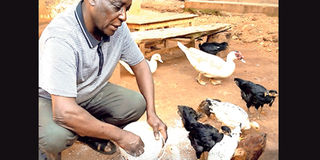Breaking News: KDF chopper crash kills five
Farmer finds formula to cut cost of production in small poultry agribusiness

Hesbon Asava in his poultry farm in Vihiga. On the farm, he has also set aside half-an-acre for growing maize, part of which he harvests and uses to make chicken feeds. PHOTO | SAMMY WAWERU | NMG
What you need to know:
- The farmer gave himself a break as he sought ways to make the business profitable.
- A 70kg bag of layers mash currently costs Sh2,400, with the farmer saying by making his own feeds, he saves half the cost.
- Maize grains are rich in carbohydrates, protein and oils. Currently, Asava, a father of four, has 25 Kienyeji chickens, having sold the bulk the previous months.
- To reduce the cost of production, he advises farmers to form groups or join saccos, which enable them raise funds to buy equipment or machines for producing own feeds.
Having worked with the Ministry of Agriculture as a field officer for over 10 years, Hesbon Asava gained immense knowledge on farming.
In his line of duty, Asava traversed different parts of the country, mingling with farmers as he addressed their challenges.
He quit in 1992 and went into horticultural farming at his home in Kasienya, Vihiga County.
“I started farming fruits, vegetables like collard greens (sukuma wiki), cabbages, spinach, tomatoes and poultry,” says Asava, who ploughed Sh120,000 into the business and also kept dairy cows.
All was well with poultry until 2013, when Asava, 66, who was then keeping over 500 birds, decided to quit due to high cost of production.
"It was a job in futility because I would buy feeds expensively but the price of eggs could not match my efforts. Besides feeds, there were also expenses associated with treatment,” he says.
The farmer gave himself a break as he sought ways to make the business profitable. “I realised that feeds were taking up to 80 per cent of my expenses. I, therefore, sought training on how to make my own feeds from various ingredients, such as maize germ, cotton seed cake, omena and sunflower cake and changed the chicken breed.”
Asava’s homemade feeds currently consist of maize grains, sunflower cake, omena, minerals and pellets, which he mixes and grinds at a posho mill.
SPECIAL FEEDS
“The mixture is crushed at a normal posho mill,” says the farmer.
A 70kg bag of layers mash currently costs Sh2,400, with the farmer saying by making his own feeds, he saves half the cost.
On his farm, he has also set aside half-an-acre for growing maize, part of which he harvests and uses to make chicken feeds.
Maize grains are rich in carbohydrates, protein and oils. Currently, Asava, a father of four, has 25 Kienyeji chickens, having sold the bulk the previous months.
Zachary Munyambu from the Kiambu Poultry Society says while home-made rations save farmers costs, they are not fit especially for chicks that need special feeds at a tender age.
“Chicks should be fed chick mash, then growers mash to boost their development. Even when making feeds at home, they should be processed according to the ages of the birds, nutrients and minerals required. Most farmers don't have this information.”
To reduce the cost of production, he advises farmers to form groups or join saccos, which enable them raise funds to buy equipment or machines for producing own feeds.
“In such groups, farmers can mobilise funds to start producing their own feeds. Groups and saccos also create avenue for market,” says Munyambu.





